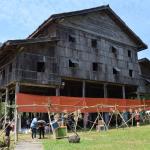Like most pancake dishes, whether they’re from Western or Eastern cuisines, tumpik is guaranteed to be both satisfying and delicious.

The word “tumpik” generally means “pancake”. It is a Melanau dish made from sago flour called ‘lemantak’ and dried coconut flakes. It is commonly made at home for personal consumption.
This local pancake is an iconic dish from a small town called Bintangor, which is about half an hour drive from Sarikei.
So, if you find yourself visiting either towns, do make some time to look for this special type of pancake – you will not regret it.
In Bintangor, you can look for stall No. 15 located at the local wet market along Jalan Teo Kin Ngo which specialises in tumpik.
The stall is owned by Haji Abang Saini B Abg Bantin and customers can choose between two types of tumpik; original and the special.
The original is basically just plain sago pancake with dried coconut flakes.

As it has a neutral taste, it is usually eaten by dipping it in sweet gula apong or palm sugar syrup.
Since the pancake is baked and not fried, you will find that it is not oily and has a nice golden brown on the surface.

It is lightly fragrant and has a nice soft crunchy texture that soaks up the sweet sauce which complements it perfectly.
The special, on the other hand, is thicker than the original tumpik since it has prawn filling.

With a chewier texture, the prawn also gives the tumpik a tangy and savoury flavour. The special tumpik is also visually pleasing as it has a beautiful white-to-pink gradient in the middle.
While both types of tumpik can be eaten with the gula apong sauce, the tumpik with prawn already has a lovely taste, and so is better on its own.
If you are not the type to go for a big breakfast, you might want to try tumpik for a change.
While sago is definitely a healthy source of carbohydrates, this pancake will leave you feeling satisfied without feeling overly full.
The changing flavours of tumpik
While the plain and fish flavour ones are the more traditional types of tumpik that have been enjoyed by Sarawakians for the longest time, these days you can find people selling tumpik with various fillings such as chocolate or jam.
In Kuching, it is said that this type of modified versions can be found in the Matang area.
While I personally have not tried any of the modern versions yet – so watch this space for another post on these unconventional flavours – reactions to these sweet version are mixed, with some still preferring the traditional tumpik.






























































































